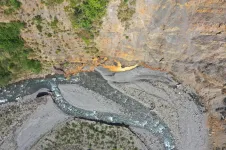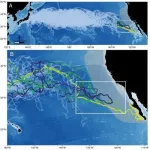(Press-News.org) Astronomers at Western University have discovered the most rapidly rotating brown dwarfs known. They found three brown dwarfs that each complete a full rotation roughly once every hour. That rate is so extreme that if these "failed stars" rotated any faster, they could come close to tearing themselves apart. Identified by NASA's Spitzer Space Telescope, the brown dwarfs were then studied by ground-based telescopes including Gemini North, which confirmed their surprisingly speedy rotation.
Three brown dwarfs have been discovered spinning faster than any other found before. Astronomers at Western University in Canada first measured the rotation speeds of these brown dwarfs using NASA's Spitzer Space Telescope and confirmed them with follow-up observations with the Gemini North telescope on Maunakea in Hawai'i and the Carnegie Institution for Science's Magellan Baade telescope in Chile. Gemini North is one of the pair of telescopes that make up the international Gemini Observatory, a Program of NSF's NOIRLab.
"We seem to have come across a speed limit on the rotation of brown dwarfs," said Megan Tannock, the Western University physics and astronomy graduate student who led the discovery. "Despite extensive searches, by our own team and others, no brown dwarfs have been found to rotate any faster. In fact, faster spins may lead to a brown dwarf tearing itself apart."
Brown dwarfs are, simply put, failed stars. They form like stars but are less massive and more like giant planets [1].
Tannock and Western University astronomer Stanimir Metchev worked with international collaborators to find three rapidly rotating brown dwarfs spinning around their axes once every hour. This is approximately 10 times faster than normal [2], and about 30 percent faster than the most rapid rotations previously measured in such objects.
The astronomers used large ground-based telescopes, Gemini North in Hawai'i and Magellan Baade in Chile, to confirm the rapid rotations. They did this by measuring alterations in the brown dwarfs' light caused by the Doppler effect and using a computer model to match those alterations to spin rates [3]. The researchers found that these brown dwarfs spin with speeds of about 350,000 kilometers per hour (around 220,000 miles per hour) at their equator, which is 10 times faster than Jupiter.
"These unusual brown dwarfs are spinning at dizzying speeds," said Sandy Leggett, an astronomer at Gemini North who studies brown dwarfs. "At about 350,000 kilometers per hour, the relatively weak gravity of the brown dwarfs is barely holding them together. This exciting discovery by the Tannock team has identified rotational limits beyond which these objects may not exist."
The team first identified the rapid rotation rates by using NASA's Spitzer Space Telescope to measure how quickly the brightness of the objects varied. "Brown dwarfs, like planets with atmospheres, can have large weather storms that affect their visible brightness," explained Metchev. "The observed brightness variations show how frequently the same storms are seen as the object spins, which reveals the brown dwarf's spin period."
The team's results will appear in an upcoming issue of The Astronomical Journal.
INFORMATION:
Notes
[1] There are four known giant planets in the Solar System: Jupiter, Saturn, Uranus, and Neptune.
[2] Stars, brown dwarfs, and planets generally spin around their axis once every 10 hours or more slowly. For example, Earth spins around its axis once every 24 hours while Jupiter and Saturn take about 10 hours. The Sun spins around its axis on average every 27 days. The Sun's rotation rate varies with latitude, with its equatorial regions completing a rotation in about 25 days and the polar regions rotating once in approximately 35 days.
[3] As each brown dwarf rotates, light from the hemisphere turning toward us appears blueshifted while light from the hemisphere turning away from us appears redshifted because of the Doppler effect. This causes absorption lines in the brown dwarf's spectrum to appear broadened (stretched both toward the red end of the spectrum and the blue end of the spectrum). By matching this broadening to a computer model, the astronomers determined how fast each brown dwarf is spinning.
More information
This research will be presented in the paper Weather on Other Worlds. V. The Three Most Rapidly Rotating Ultra-Cool Dwarfs, to appear in The Astronomical Journal.
The team is composed of Megan Tannock (Western University), Stanimir Metchev (Western University and American Museum of Natural History), Aren Heinze (University of Hawai'i), Paulo A. Miles-Páez (European Southern Observatory), Jonathan Gagné (Planétarium Rio Tinto Alcan and Université de Montréal), Adam Burgasser (University of California, San Diego), Mark S. Marley (NASA Ames Research Center), Dániel Apai (University of Arizona), Genaro Suárez (Western University), and Peter Plavchan (George Mason University).
NSF's NOIRLab (National Optical-Infrared Astronomy Research Laboratory), the US center for ground-based optical-infrared astronomy, operates the international Gemini Observatory (a facility of NSF, NRC-Canada, ANID-Chile, MCTIC-Brazil, MINCyT-Argentina, and KASI-Republic of Korea), Kitt Peak National Observatory (KPNO), Cerro Tololo Inter-American Observatory (CTIO), the Community Science and Data Center (CSDC), and Vera C. Rubin Observatory (in cooperation with DOE's SLAC National Accelerator Laboratory). It is managed by the Association of Universities for Research in Astronomy (AURA) under a cooperative agreement with NSF and is headquartered in Tucson, Arizona. The astronomical community is honored to have the opportunity to conduct astronomical research on Iolkam Du'ag (Kitt Peak) in Arizona, on Maunakea in Hawai?i, and on Cerro Tololo and Cerro Pachón in Chile. We recognize and acknowledge the very significant cultural role and reverence that these sites have to the Tohono O'odham Nation, to the Native Hawaiian community, and to the local communities in Chile, respectively.
Contacts
Megan Tannock
Western University
Email: mtannock@uwo.ca
Stanimir Metchev
Canada Research Chair in Extrasolar Planets
Institute for Earth and Space Exploration, Western University
Email: smetchev@uwo.ca
Amanda Kocz
Press and Internal Communications Officer
NSF's NOIRLab
Cell: +1 626 524 5884
Email: amanda.kocz@noirlab.edu
Taiwan is an island of extremes: severe earthquakes and typhoons repeatedly strike the region and change the landscape, sometimes catastrophically. This makes Taiwan a fantastic laboratory for geosciences. Erosion processes, for example, occur up to a thousand times faster in the center of the island than in its far south. This difference in erosion rates influences the chemical weathering of rocks and yields insights into the carbon cycle of our planet on a scale of millions of years. A group of researchers led by Aaron Bufe and Niels Hovius of the German Research Center for Geosciences (GFZ) has now taken advantage of the different erosion rates and investigated how uplift and erosion of rocks determine the balance of carbon emissions ...
Having a responsive, supportive partner minimizes the negative impacts of an individual's depression or external stress on their romantic relationship, according to research by a University of Massachusetts Amherst social psychologist.
Paula Pietromonaco, professor emerita of psychological and brain sciences, drew on data from her Growth in Early Marriage project (GEM) to investigate what she had discovered was an under-studied question. Findings are published in the journal Social Psychological and Personality Science.
"I was really surprised that although there's a ton of work out there on depression, there ...
Boulder, Colo., USA: Gale Crater's central sedimentary mound (Aeolis Mons or, informally, Mount Sharp) is a 5.5-km-tall remnant of the infilling and erosion of this ancient impact crater. Given its thickness and age, Mount Sharp preserves one of the best records of early Martian climatic, hydrological, and sedimentary history.
In this paper, published today in Geology, William Rapin and colleagues present the first description of key facies in the sulfate-bearing unit, recently observed in the distance by the rover, and propose a model for changes in depositional environments.
The basal part of this sedimentary sequence is ahead of the Curiosity rover traverse and was recently analyzed with unprecedented resolution by the rover ...
While it isn't surprising that infants and children love to look at people's movements and faces, recent research from Rochester Institute of Technology's National Technical Institute for the Deaf studies exactly where they look when they see someone using sign language. The research uses eye-tracking technology that offers a non-invasive and powerful tool to study cognition and language learning in pre-verbal infants.
NTID researcher and Assistant Professor Rain Bosworth and alumnus Adam Stone studied early-language knowledge in young infants and children by recording their gaze patterns as they watched a signer. The goal was to learn, just from gaze patterns alone, ...
"Not all those who wander are lost ... "
--J.R.R. Tolkien
Known as "the lost years," it is a little-understood journey that unfolds over thousands of miles and as much as two decades or more. Now, a Stanford-led study illuminates secrets of the North Pacific loggerhead turtles' epic migration between their birthplace on the beaches of Japan and reemergence years later in foraging grounds off the coast of Baja California. The study, published April 8 in Frontiers in Marine Science, provides evidence for intermittent passages of warm water that allow sea turtles to cross otherwise inhospitably cold ocean barriers. The findings could help inform the design of conservation measures to protect sea turtles and other migratory sea creatures amid climatic ...
The Perseverance rover has just landed on Mars. Meanwhile, its precursor Curiosity continues to explore the base of Mount Sharp (officially Aeolis Mons), a mountain several kilometres high at the centre of the Gale crater. Using the telescope on the ChemCam instrument to make detailed observations of the steep terrain of Mount Sharp at a distance, a French-US team headed by William Rapin, CNRS researcher at the Institut de Recherche en Astrophysique et Planétologie (CNRS/Université Toulouse III/CNES) (1), has discovered that the Martian climate recorded there alternated between dry and wetter periods, before drying up completely about 3 billion years ago. Spacecraft in orbit ...
Heart failure and stroke are unusual diagnoses among younger people. But they are now clearly on the rise in men below the age of 40, according to a University of Gothenburg study. The scientists have found links to obesity and low fitness in the upper teens.
The present study, published in Journal of Internal Medicine, includes data on 1,258,432 men who, at an average age of 18.3 years, enlisted for military service in Sweden between 1971 and 1995.
Particulars of the men's weight, height and physical fitness on enlistment were merged with data in the National Board of Health and Welfare's National Patient Register and Cause of Death Register for the period 1991-2016. From when they enlisted, the men were thus monitored over a period exceeding 20 years.
The proportion ...
Researchers at GMI - Gregor Mendel Institute of Molecular Plant Biology of the Austrian Academy of Sciences - uncover an ingenious mechanism by which Arabidopsis safeguards the integrity of its genome. The paper is published in the journal Nature Cell Biology.
Is it possible for one single gene product to silence undesirable genetic elements? Can such a strong effect be seen in the regulation of Transposable Elements (TEs), or genome parasites? If yes, how does this gene product singlehandedly keep transposons in check? New research from Frédéric Berger's group at GMI provides answers to these questions and dissects a mechanism of gene silencing that has long remained shrouded in mystery.
Genome parasites
Although jumping transposons promote ...
Flamingo chicks raised by foster parents from another flamingo species develop normally, scientists say.
Six Chilean flamingo chicks were reared by Andean flamingos - a species of similar size and behaviour - at WWT Slimbridge Wetland Centre in the summer of 2018.
University of Exeter scientists studied the chicks' behaviour after they re-joined the Chilean flamingo flock early in 2019.
The results showed fostering had no negative effects, with fostered flamingos still forming stable social ties - making "friends" and behaving like parent-reared birds.
"Slimbridge's Andean flamingos hadn't nested for about 20 years," said Dr Paul Rose, of the University of Exeter.
"But in the ...
Novel PF74-like small molecules targeting the HIV-1 capsid protein: Balance of potency and metabolic stability
https://doi.org/10.1016/j.apsb.2020.07.016
Of all known small molecules targeting human immunodeficiency virus (HIV) capsid protein (CA), PF74 represents by far the best characterized chemotype, due to its ability to confer antiviral phenotypes in both early and late phases of viral replication. However, the prohibitively low metabolic stability renders PF74 a poor antiviral lead. The authors report on their medicinal chemistry efforts ...







